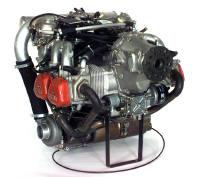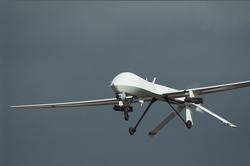Probably Without the Hellfires...
The Air Force officer is a transport plane pilot, but these days
his aircraft flies "solo," and he doesn't leave the ground. Capt.
Sam J. Vanzanten, is an earthbound controller of the Predator
unmanned aerial vehicle. He's been in the Predator program for the
past two years, the eight-year military veteran said.

Vanzanten, his armaments specialist, Tech. Sgt. George H.
Russell and their Predator were at Andrews Air Force Base (MD), May
16 for the kickoff ceremony at this year's Joint Service Open
House. He'd put his UAV expertise to the test overseas in support
of Operation Enduring Freedom in Afghanistan and Operation Iraqi
Freedom, the C-17 transport pilot said.
The Predator was first used exclusively for reconnaissance
missions, Vanzanten said. Unlike conventionally piloted aircraft,
the UAV can remain airborne over a particular area for up to 20
hours.
Predators equipped with Hellfire missiles flew combat missions
in Afghanistan and Iraq, the captain said. "People just started
opening their eyes to the capability of the aircraft," he said,
noting the Predator can play multifaceted roles over the
battlefield.
Even if the Predator isn't armed, "we at least have a camera and
a radio to 'talk' to other aircraft in the area," Vanzanten said,
to communicate target locations to pilots of conventional
warplanes.
 The Predator uses a lightweight, 4-cylinder
snowmobile engine, Vanzanten said [no -- it uses a Rotax 914, which
is, and was always designed to be, an aircraft engine --ed.], which
powers a rear-mounted propeller.
The Predator uses a lightweight, 4-cylinder
snowmobile engine, Vanzanten said [no -- it uses a Rotax 914, which
is, and was always designed to be, an aircraft engine --ed.], which
powers a rear-mounted propeller.
He watches a television monitor that displays images transmitted
from the Predator's nose-mounted camera in remotely piloting the
2,250-pound UAV, Vanzanten said. The craft, he said, "flies quite a
bit like a [motor] glider, or a light aircraft."
Piloting the Predator takes some getting used to. "Learning how
to land the UAV is a little difficult for everybody, I think,"
Vanzanten said.
While other military aircraft braved the rainy weather outside
at the Open House, the remote-controlled plane, which was fitted
with two wing-mounted, laser-guided Army Hellfire missiles, was
ensconced inside Hanger 3. The Hellfires can penetrate enemy armor
and "were originally used on the Apache and the Cobra" Army
helicopters, Russell said. "It's really an effective missile. I've
seen it in action – it's very impressive," Russell said,
noting he's worked with Predators for about a year. He continued,
"The whole idea of an unmanned aerial vehicle – keeping
people out of harm's way -- is a phenomenal idea." The Predator's
composite airframe, he said, is easy to work on.
 The employment of Predators in the war against
global terrorism "offers a lot of different capabilities,"
Vanzanten said, pointing out the UAV's "laser-ball" device that's
used to guide the Hellfires to target.
The employment of Predators in the war against
global terrorism "offers a lot of different capabilities,"
Vanzanten said, pointing out the UAV's "laser-ball" device that's
used to guide the Hellfires to target.
The Predator has been used in joint-combined operations. During
recent overseas deployments U.S. Air Force Predator crews worked
with members of the other armed services, as well as British
coalition forces.
Maj. Mark Valentine, an F-16 fighter pilot with the 113th
Operations Group, 121st Fighter Squadron, District of Columbia Air
National Guard, was also at the May 16 Andrews Open House kickoff.
Valentine, who'd recently returned stateside after flying combat
missions during Operation Iraqi Freedom, praised the Predator.
The integration between conventionally-piloted aircraft and UAVs
was "outstanding" during the Iraq war, the major said.
"(Predator pilots) would identify a target and we would drop
(ordnance) on the target – that would happen quite often,"
Valentine said. "(UAVs) obviously have the endurance to stay in an
area a lot longer than we have, because they use less gas."
[Thanks to Gerry J. Gilmore, American Forces Press Service
--ed.]
 Airbus Racer Helicopter Demonstrator First Flight Part of Clean Sky 2 Initiative
Airbus Racer Helicopter Demonstrator First Flight Part of Clean Sky 2 Initiative Diamond's Electric DA40 Finds Fans at Dübendorf
Diamond's Electric DA40 Finds Fans at Dübendorf ANN's Daily Aero-Term (04.23.24): Line Up And Wait (LUAW)
ANN's Daily Aero-Term (04.23.24): Line Up And Wait (LUAW) NTSB Final Report: Extra Flugzeugbau GMBH EA300/L
NTSB Final Report: Extra Flugzeugbau GMBH EA300/L Classic Aero-TV: 'Never Give Up' - Advice From Two of FedEx's Female Captains
Classic Aero-TV: 'Never Give Up' - Advice From Two of FedEx's Female Captains





